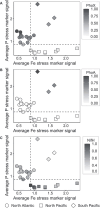Trichodesmium metaproteomes reflect the differential influence of resource availability across ocean regions
- PMID: 40476730
- PMCID: PMC12206446
- DOI: 10.1093/ismejo/wraf120
Trichodesmium metaproteomes reflect the differential influence of resource availability across ocean regions
Abstract
The diazotroph Trichodesmium is an important contributor to marine dinitrogen fixation, supplying nitrogen to phytoplankton in typically nitrogen-limited ocean regions. Identifying how iron and phosphorus influence Trichodesmium activity and biogeography is an ongoing area of study, where predicting patterns of resource stress is complicated by the uncertain bioavailability of organically complexed iron and phosphorus. Here, a comparison of 26 metaproteomes from picked Trichodesmium colonies identified significantly different patterns between three ocean regions: the western tropical South Pacific, the western North Atlantic, and the North Pacific Subtropical Gyre. Trichodesmium KEGG submodule signals differed significantly across regions, and vector fitting showed that dissolved iron, dissolved inorganic phosphorus, and temperature significantly correlated with regional metaproteome patterns. Patterns of iron and phosphorus stress marker proteins previously validated in culture studies showed significant enrichment of a phosphorus stress signal in the western North Atlantic and an iron stress signal in the North Pacific. Populations in the western tropical South Pacific appeared to modulate their proteomes in response to both dissolved iron and dissolved inorganic phosphorus bioavailability, with significant enrichment of iron and phosphorus stress marker proteins, concomitant proteome restructuring, and significant decreases in the relative abundance of the dinitrogen fixation protein, NifH. These signals recapitulate established regional patterns of resource stress on phytoplankton communities released from nitrogen stress. Evaluating community stress patterns may therefore predict resource controls on diazotroph biogeography. These data highlight how Trichodesmium modulates its metabolism in the field and provide an opportunity to more accurately constrain controls on Trichodesmium biogeography and dinitrogen fixation.
Keywords: Trichodesmium; co-limitation; diazotrophy; metaproteomics.
© The Author(s) 2025. Published by Oxford University Press on behalf of the International Society for Microbial Ecology.
Conflict of interest statement
There was no conflict of interest in the production of this work.
Figures





References
-
- Moore CM, Mills MM, Arrigo KR. et al. Processes and patterns of oceanic nutrient limitation. Nat Geosci 2013;6:701–10. 10.1038/ngeo1765 - DOI
-
- Berthelot H, Bonnet S, Grosso O. et al. Transfer of diazotroph-derived nitrogen towards non-diazotrophic planktonic communities: a comparative study between Trichodesmium erythraeum, Crocosphaera watsonii and Cyanothece sp. Biogeosciences 2016;13:4005–21. 10.5194/bg-13-4005-2016 - DOI
MeSH terms
Substances
Grants and funding
LinkOut - more resources
Full Text Sources

